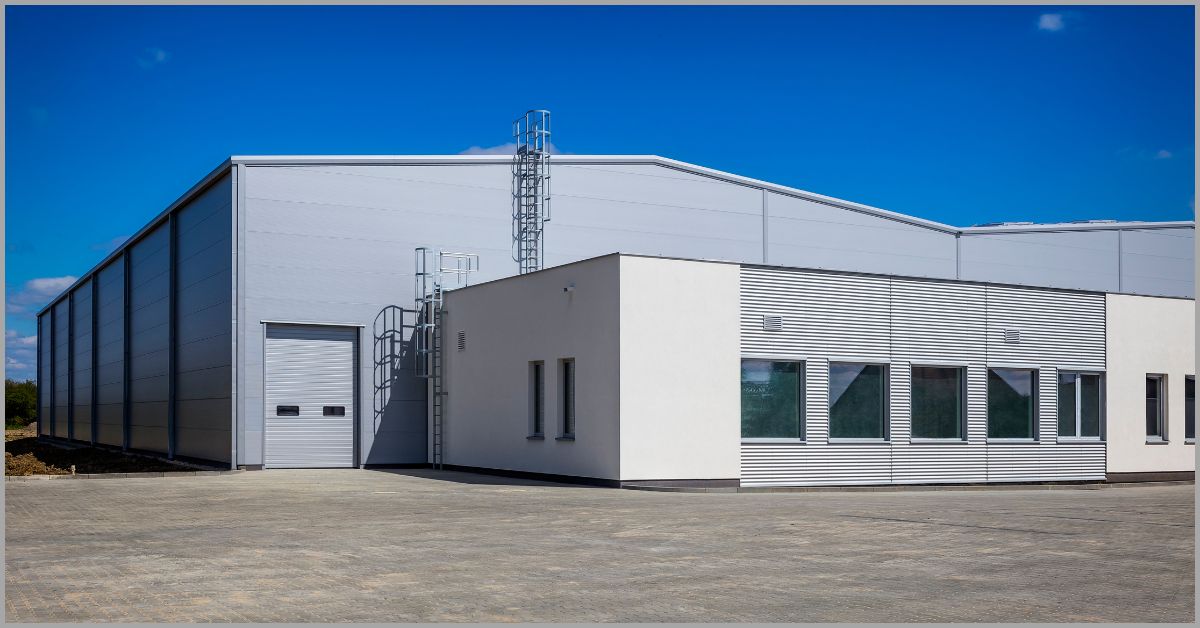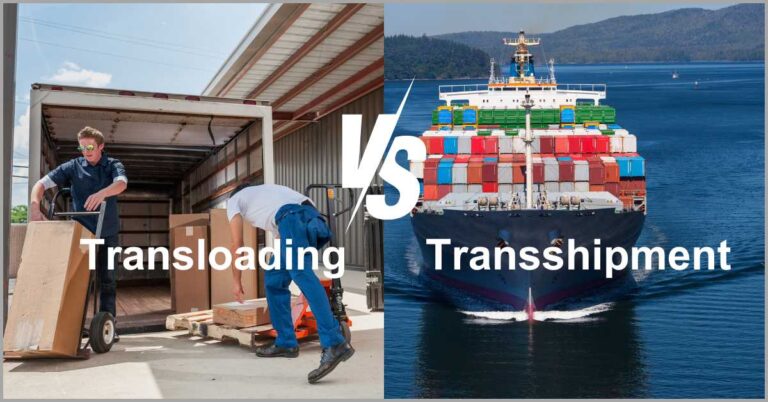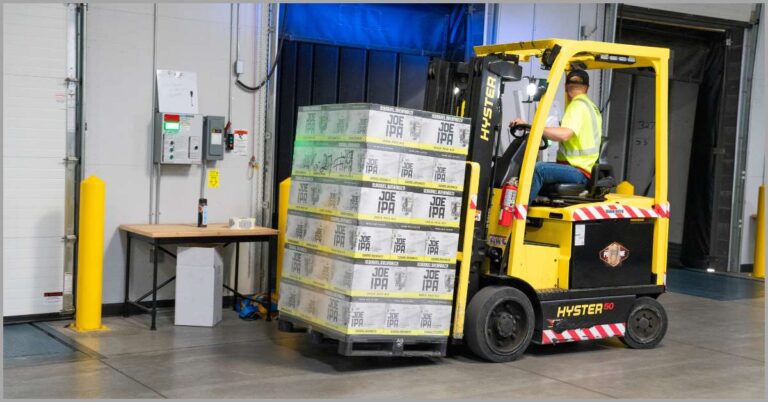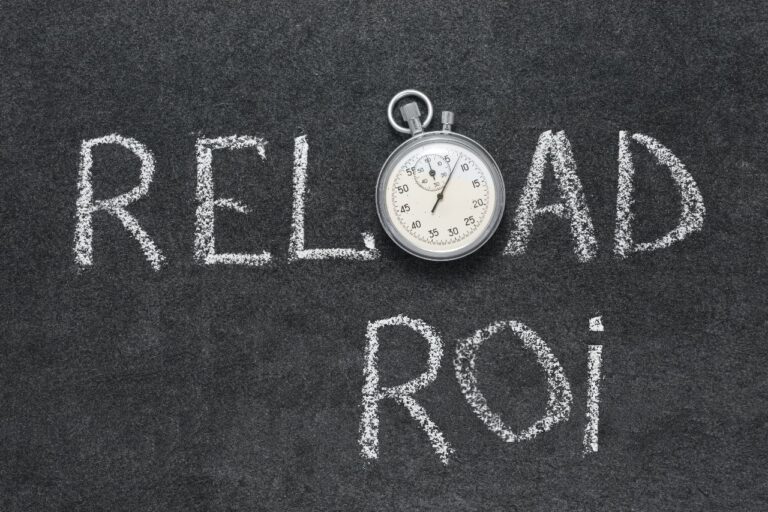How to Start a Warehouse Business in 2024 [10 Tips to Get Started]
Want to start a warehouse business?
Acting on profitable warehouse business ideas can be both exciting and daunting.
It’s intimidating because starting your warehouse business attracts unique considerations compared to other niches and requires industry expertise.
In fact, a Zapier survey revealed that 92% of would-be entrepreneurs never follow through on their ideas. It emerged that insufficient industry knowledge was among the biggest hindrances.
So if you’re trying to figure out how to start a warehouse business, the first step involves getting a better understanding of the warehousing industry.
From special licenses you’ll need to operate legally to landing your first customer as a budding warehouse business with a relatively unknown name, mastering the unique dynamics of warehousing is essential for attaining and maintaining success.
In this article, we’ll discuss how to start a warehouse business in 2024 to help you create a profitable and sustainable business you can be proud of.
Let’s get started.
1. Draft a business plan
A successful business starts with a great business plan.
This is a very important document on which you’ll list your career goals, the objective for your business and other essential details that shepherd growth. Overall, your business plan is like a sailor’s map, and will guide you toward success.
If you skip writing a business plan, you can easily lose direction while it’ll also become extremely difficult to secure funding from investors and banks.
In fact, a recent study by GoodFirms revealed that over 70% of businesses that are successful have a solid business plan in place. By documenting their vision and goals, they’re able to anticipate future needs and they thrive because of it.
Therefore, before you act on any ideas, I suggest taking the time to write a clear and elaborate business plan.
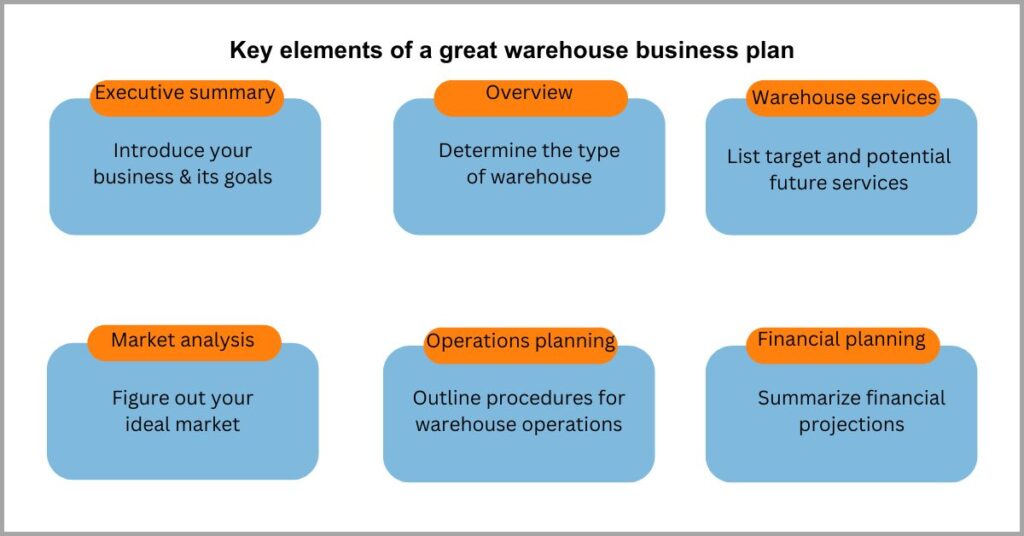
So how do you come up with a business plan?
Before you put ink to paper, you need to figure out the services you’d like to offer.
For instance, you can choose to exclusively provide warehousing services or you may set out to be one of the best transload service companies and provide transloading services alongside other primary offerings.
Once you’ve figured out your particular niche, you can now proceed to draft a vision and mission. These should describe both your short term and long-term goals and even detail key performance indicators at each stage to help you assess progress.
Furthermore, your warehouse business plan should also anticipate challenges.
This may revolve around pinpointing issues like securing funding or how you aim to beat the competition, for instance, so that you can proactively address potential hurdles.
2. Perform competitive analysis
Who are the competitors for your warehouse business?
Figuring out who your alternatives are is one of the first and most important steps to cracking how to start a warehouse business. This is because not doing so can make it challenging for you to find opportunities to exploit to make your services stand out.
In addition, neglecting competitive analysis may also result in you missing tertiary marketing opportunities, therefore lowering your revenue potential.
For the average company, 65% of all sales opportunities are competitive, according to a study by Crayon. So there’s certainly no shortage of fierce competition, no matter what niche of warehousing you decide to take up.
By really understanding what you’re up against, you can identify opportunities to outcompete other players and establish yourself as the warehouse of choice.
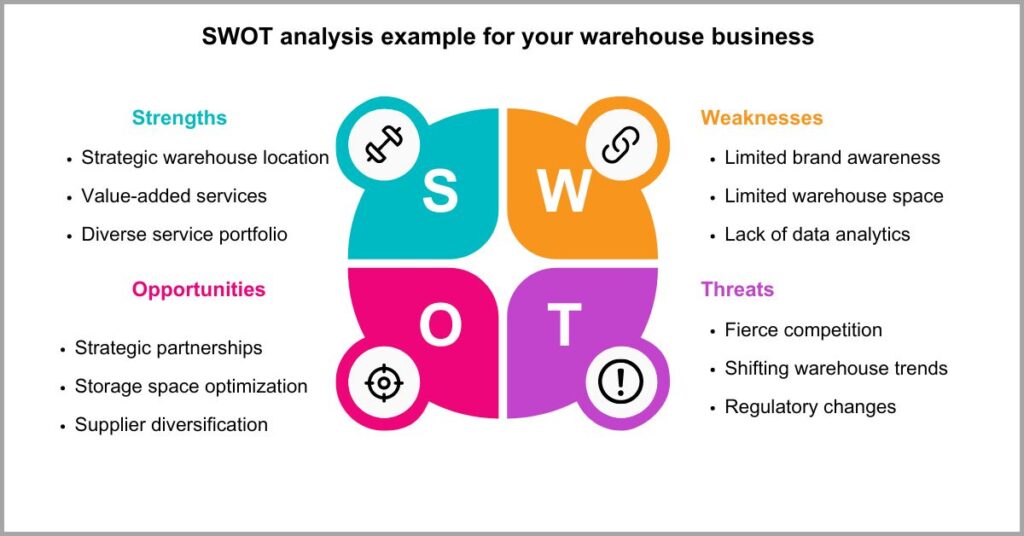
At this point, you may already have a specific niche you want to zero in on.
This provides an excellent base on which to launch your competitive analysis strategies. For example, if you aim to provide critical railroad logistics strategies as a 3PL provider with its own warehousing, you need to assess competitors offering similar services.
So you’ll want to look up such entities in your area, scrutinize their range of services, and determine if you can match this and even provide value-added services they may not offer. Doing so will make your business more appealing to clients.
In terms of strategies, I particularly recommend the Strengths Weaknesses Opportunities and Threats (SWOT) formula.
This competitive analysis tactic will help you figure out where your business falls short, identify stand-out attributes and understand threats to your business.
3. Assess financing options
It takes huge capital investments to start a warehouse.
From paying staff and footing utilities to procuring equipment and investing in warehousing space, you’ll need to dig deep to get your warehouse up and running, and chances are you may not have all the capital you need right out of the gate.
Without the right financial foundation to bring your warehouse to life, this can impede growth, decrease operational efficiency and even lead to insolvency.
A study by CB insights revealed that 38% of new businesses bite the dust because of failing to secure funding. This made it the leading cause of startup failure, followed by a lack of market need and these businesses getting outcompeted.
Therefore, an important part of figuring out how to start a warehouse business is being able to secure the funding that enables your survival.
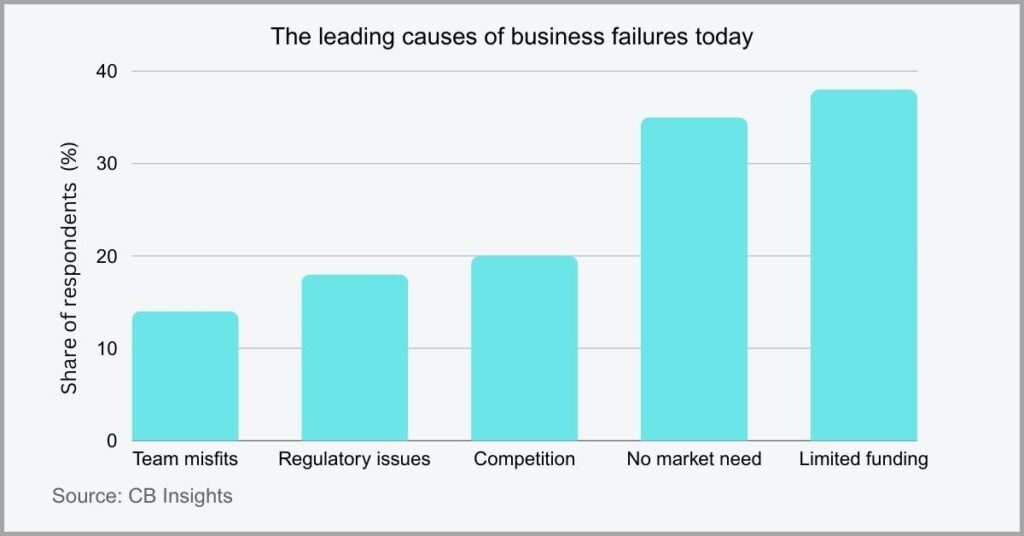
So what financing options are on the table?
The two most popular financing strategies I’ve witnessed generally revolve around investor funding and industrial warehouse loans.
Investor funding is a great way to raise funds both from within and outside your circles to start your warehouse transloading shipping service with a healthy cash flow. The huge downside is that you’ll offer ownership stakes in exchange for the funds.
Alternatively, you can also secure an industrial warehouse loan from your bank, which is ideal if you’d like to get commercial financing without giving up a part of ownership.
Industrial loans, notably, may offer higher interest rates and implement strict eligibility requirements. So it’s important to weigh both options carefully to figure out the best way to go for your warehouse business depending on your goals and preferences.
4. Acquire warehousing space
Should you buy or lease a warehouse?
For you to have a warehouse business, you’ll certainly need warehouse space. Here, you can go about it in one of three ways, namely you can choose to buy an existing warehouse, lease one or build the warehouse from scratch.
Working out the best way to procure warehousing space is key to lowering upfront costs, which if too high, can increase the risk of business failure.
In 2023, warehouse and distribution rents soared to $9.72 per square foot, according to a study by Colliers. This represented a 20.6% year on year increase, making this the highest ever recorded warehouse rental prices.
So if you’re to make your warehouse profitable, you need to determine whether you’ll need to buy or lease space to keep upfront and maintenance costs low.
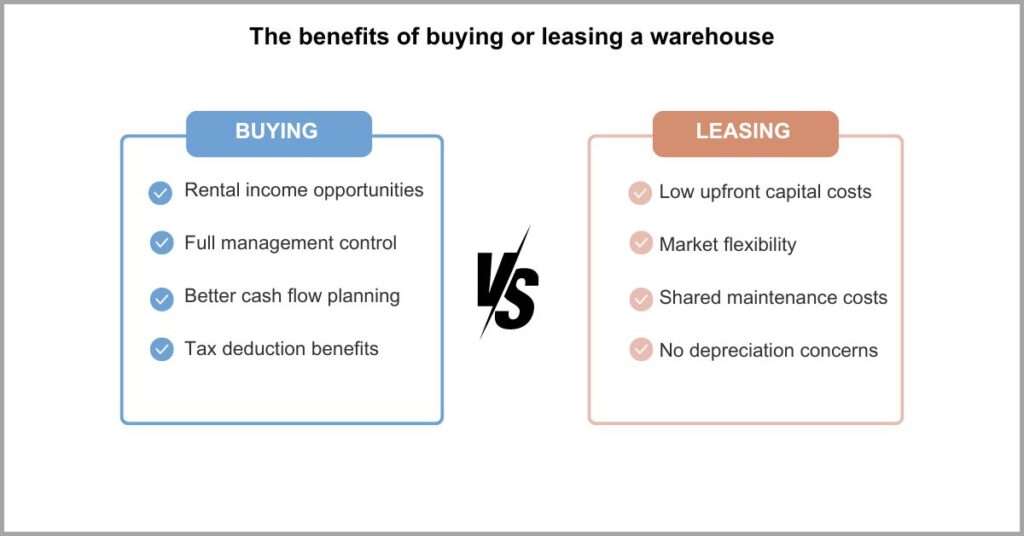
It’s ideal to buy a warehouse if it’s an area with great access to busy shipping lanes or if it generally taps into a favorable market. The benefits of acquiring a warehouse this way is you can build up equity over time, although mortgage expenses can be significant.
Conversely, you may lease transloading or intermodal shipping warehouse spaces.
This is prudent if you’ll be getting into this niche of warehousing because you’ll have a floor layout that needs little needs for customization. Overall, leasing helps you avoid tethering your market to a physical property although you lose out in terms of equity.
The third option you have is building a warehouse from scratch.
This is the way to go if you want great control over your warehouse’s design and layout, however, it’s the most expensive way to acquire warehouse space.
5. Secure necessary permits
The warehousing industry is highly regulated.
We have various regulatory agencies and legislations at play like the FDA and OSHA. They create and implement various guidelines and standards for warehouse operations in a bid to ensure a safe working environment for workers and protect consumer data.
Overall, running your warehouse business involves juggling several regulations, and this is key to avoiding hefty penalties that can put you out of business.
A Globalsacpe study revealed that businesses lose about $14.82 million yearly to various non-compliance related issues. This amount comes from compliance violation fines and the cost of footing customer lawsuits as well.
So one of the most important aspects of how to start a warehouse business from scratch is to first figure out your licensing and compliance obligations.
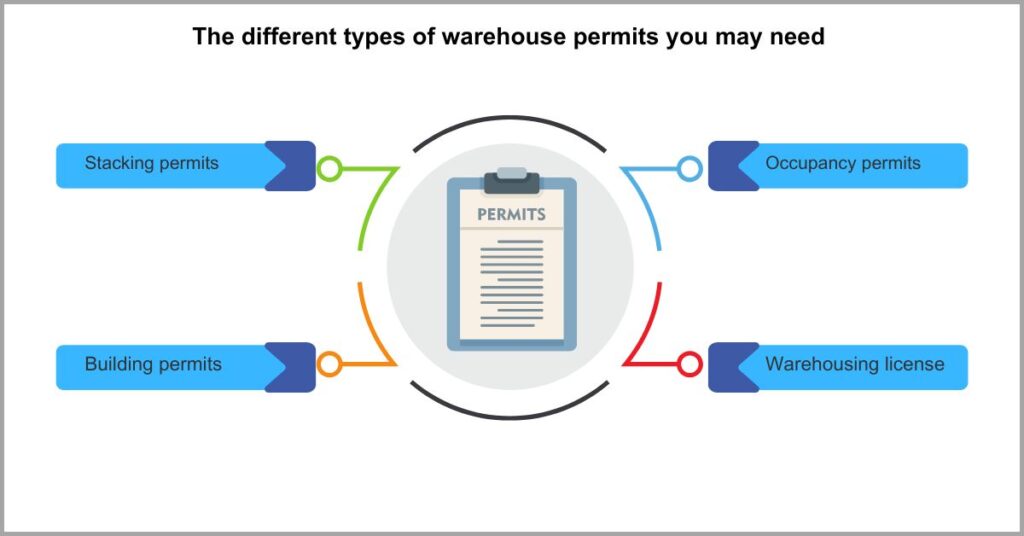
But what permits will I need for my warehouse business?
If you’re going to construct a warehouse or make any changes to an existing warehouse’s floor space, you’ll need a building permit and inspection reports.
However, you may have already found a warehouse that requires no modifications.
But before you can monetize your warehouse space in this case, you’ll generally need to secure a warehousing license. This indicates that the structure is legally certified to store and distribute goods.
It’s important to note though that the specific type of warehousing license will depend on the type of freight you handle. For instance, you may need special approvals and licenses in case you’ll be dealing with bonded goods.
Furthermore, you may also need warehouse racking permits to show that your racking arrangements observe standards set by local authorities in your state.
6. Procure warehouse equipment
Want to run a profitable and successful business?
Determining the right warehouse tools to invest in is essential to helping you get the most out of your warehouse workers. Investing in the wrong equipment, however, can mean a sizable amount of investments going down the drain.
Moreover, if you lack the right warehouse equipment, this can greatly lower your warehouse business’ productivity while increasing the risk of onsite injuries.
A survey by HBR revealed that 38% of warehouse workers say the use of various automation equipment and technologies makes them more efficient and productive. Nearly half the same number further added that they enhance warehouse safety.
So while they may attract huge initial capital requirements, investing in the right technologies is key to helping you realize a safer and more productive warehouse.
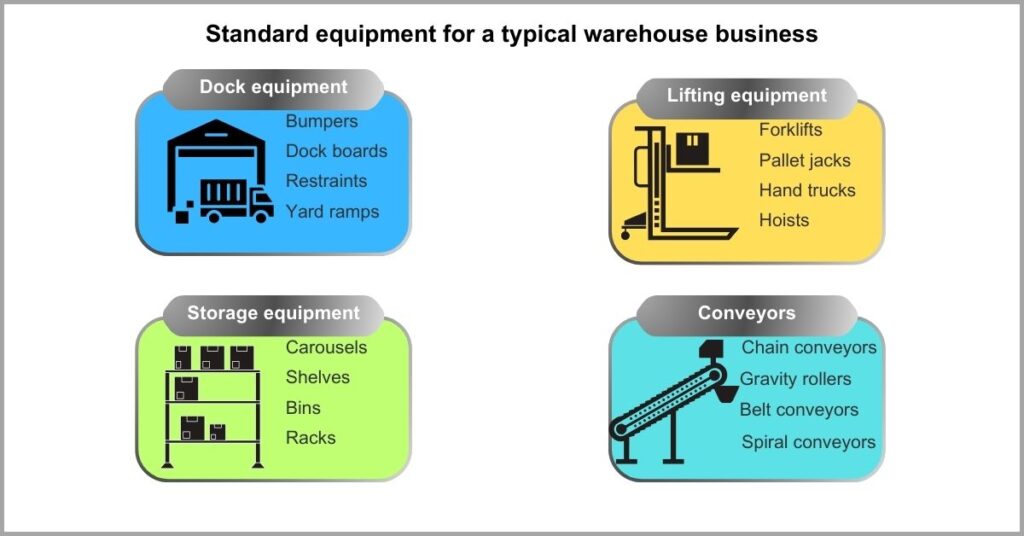
Of course, the specific types of equipment you’ll buy depends on what type of warehouse you intend to run.
An e-commerce fulfillment center, for instance, may need tools to facilitate the individual picking and packing of items. For transload service companies, you may need tools that are specifically geared toward the efficient handling of bulk goods.
Either way, some standard equipment you’ll need to boost productivity in a typical warehouse include dock, conveyors, lifting and storage equipment.
When choosing warehouse equipment, there are few vital things to consider.
You’ll need to ascertain that it meets your operational needs in terms of your specific storage requirements, inventory volume and your warehouse’s layout and size to censure excellent ROI.
It’s important to familiarize with its training requirements and also determine if it will necessitate physical infrastructure upgrades to avoid unexpected cost surprises.
7. Build the right team
No warehouse can run without a great team.
And to build a great team, you also need to implement a very high-quality hiring process. Otherwise, you can hire warehouse staff who don’t align with your culture, lack the right skill sets and obstruct growth.
When you make poor hiring decisions, this can also lead to higher turnover rates and expenses, which can be very dire for a business hoping to find its feet.
In fact, the price of a bad hire is quite literally too high, with a survey by CareerBuilder revealing that each poor hiring decision costs businesses $17,000. These losses stem from poor quality of work, lost wages and costly rehiring processes.
It’s therefore important to implement high quality hiring processes if you’re to learn how to start a warehouse business that’s likely to succeed.
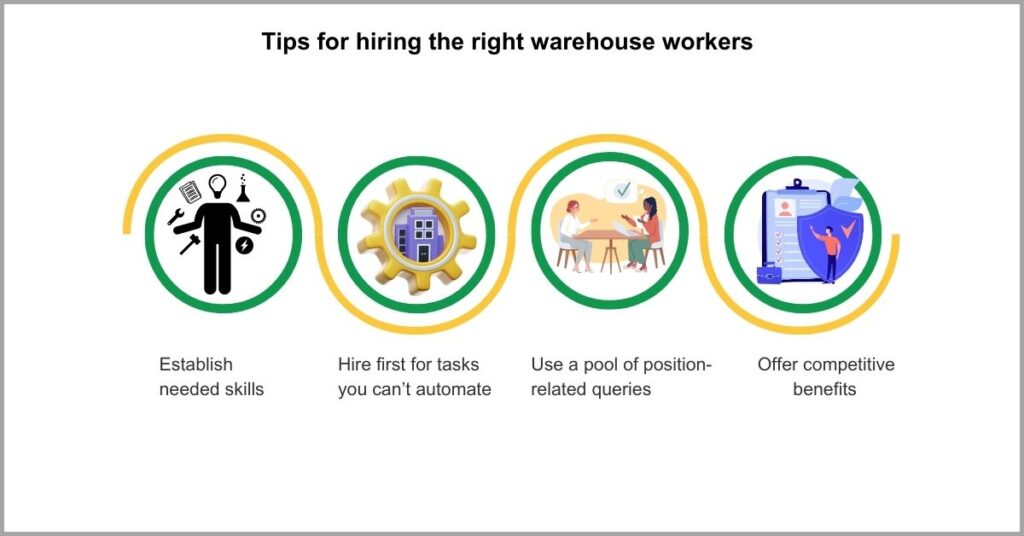
So what should you consider when hiring warehouse staff?
You should first start by considering the skills you’re looking for, depending on equipment you intend to procure and the nature of your warehouse operations.
This may mean considering hiring forklift operators, material handlers, stockers and so on, to help you get the most out of warehouse technologies and improve productivity.
It’s also prudent to consider B2B warehouse management solutions to automate routine tasks that can be huge time and revenue drains for your business. Such solutions can automate iterative work so that you can cut back on your labor needs and expenses.
When hiring warehouse staff, I additionally recommend implementing a system for anticipating seasonal increases in workloads. This will help you establish a temporary and permanent staff hiring formula that’s most profitable for your warehouse business.
8. Invest in warehouse management software
Want to manage warehouse processes efficiently?
While your warehousing workflow may sound straightforward at first, it will generate several tasks that can be hard to manage manually. This includes processes related to managing inventory, workers, and fulfillment, just to name a few.
Overall, the lack of an excellent warehouse management system or WMS can lead to poor operational intelligence that allows process inefficiencies to flourish.
A survey by LM revealed that 85% of warehouses use a warehouse management system and many more plan to invest in them very soon. This represents a growing trend as more businesses are using these tools to eliminate various inefficiencies.
Some other key reasons why WMSs are gaining popularity is their ability to enhance warehouse space utilization, improve inventory tracking and elevate warehouse worker productivity and performances.
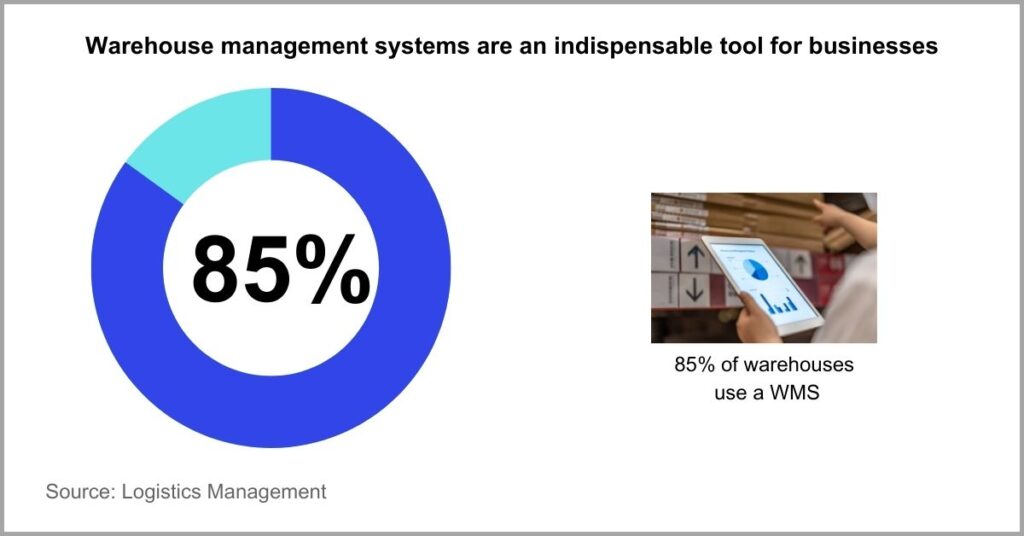
However, not all warehouse management systems are right for your business.
This is why you’ll need to pay very close attention to what features they offer, and if these capabilities match the unique needs of your particular warehouse workflow.
For instance, you should consider essential transloading software features that are niche-specific if you’ll be running a transloading warehouse. Our software, transloads.co is a great option here since it offers industry-specific features for improving transloading.
The point is to assess your business’s unique needs so that you get a software that solves your workflow’s unique obstacles and fuels your business’s goals.
Moreover, the right WMS should offer great flexibility and scalability, and preferably be cloud-based. This allows it to accommodate changes you make to your business model, and handle growing inventory volumes to ensure a long-term, cost-efficient solution.
9. Find customers for your business
Customers are your business’s lifeblood.
They directly affect your cash flow, and will determine the fate of your warehouse. If you fail to generate enough revenue, growth will be nearly impossible to achieve and, sooner or rather, your workflow will reach the point of unsustainability.
However, as a new and unproven warehouse business, finding customers can be very challenging without the right customer acquisition strategies.
The situation is very dire today with 60% of businesses ranking customer acquisition as the biggest challenge they face in 2024, going by a recent survey from Constant Contact. Many of these businesses end up failing because of this.
So in this guide on how to start a warehouse business, nailing your customer acquisition strategy is key to ensuring a reliable and healthy revenue stream for your business.
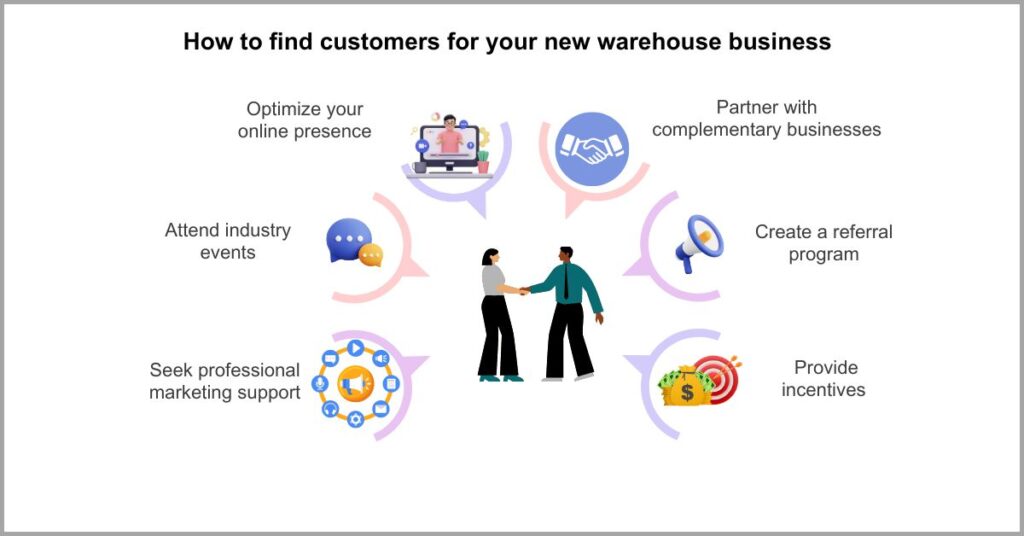
But how can you get new and high-quality clients fast?
To build trust with your market, I recommend setting up introductory offers to sweeten the pot. This can include discounts on warehouse storage, or complimentary bonuses services like effective railcar switching and free transloading to incentivize acquisition.
Moreover, you can also choose to partner with related businesses that share a similar market base as your warehouse business but aren’t really your direct competitors.
It’s also important to establish a robust online presence by seeking digital marketing services that can help you increase brand awareness and expand your reach.
Our company, transloads.co, offers premium support services, including marketing.
If you’ll be running a transloading warehouse and need assistance optimizing yard operations and getting clients, we may be able to help you hit the ground running.
10. Review warehouse performances
Want to run a successful warehouse business?
Then it’s important to quantify performance with very specific KPIs. Otherwise, it’ll be very difficult to understand your business’s financial health while this will also make it easy to waste resources on services that generate very little revenue.
Ultimately, if you fail to measure and track warehouse performances, you can make uninformed decisions that negatively impact cash flow.
A study by Geckoboard revealed that 74% of businesses who set, track and review KPIs in real time hit their growth targets. This is definitely not a coincidence and emphasizes the need to re-evaluate your warehouse business’s performance regularly.
Doing so allows you to keep your business agile and ahead of market changes and it helps you to get the feedback you need to cut out process waste & raise productivity.
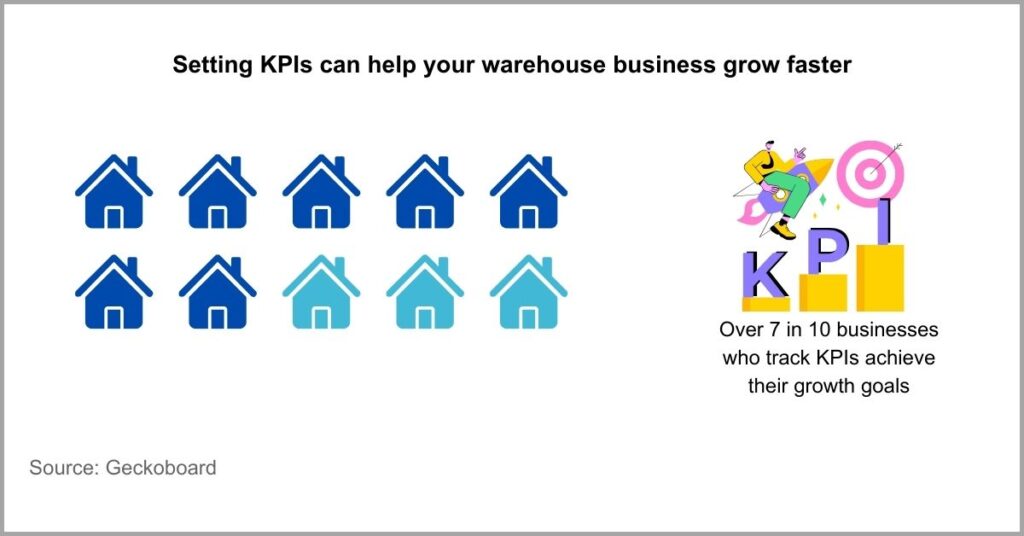
In terms of important success metrics to track, I recommend setting and tracking your break-even point to ensure that your business is at least not making losses.
Once that is established, you should also monitor your net income ratio, which is income you make after taking out expenses. Having a good perception of your profit margins and its key drivers is essential for improving revenue generation.
If you’ve invested in the best B2B inventory management solutions, and other technologies, you also want to calculate their ROI and abandon systems that aren’t pulling their weight.
For your warehouse workers, meanwhile, periodic performance reviews are necessary to improve worker output.
When you regularly review your warehouse business’s processes and resources, you can identify and solve problems before they negatively impact performance while you can also easily spot profitable opportunities to pursue.
Conclusion
Starting a warehouse business is easy.
Making it profitable and financially sustainable is where you have your work cut out.
If you’re to get great ROI from your warehouse business, you need to improve key processes that hugely determine profit margins like inventory management.
In fact, a Statista study proved that warehouses lose $568.7 billion annually to poor inventory management alone. Consequently, this caused inventory distortion that resulted in very costly understocking and overstocking situations.
So an essential part of learning how to start a warehouse business also involves identifying and improving essential processes that affect your profit margins like inventory management. Fortunately, our software transloads.co can help you out.
Click here to start your free transloads.co trial for robust, real-time inventory tracking that increases efficiency and accuracy.
With our platform, you’ll optimize stock levels more effectively for your warehouse business, which will help you decrease operational costs and increase revenue.

